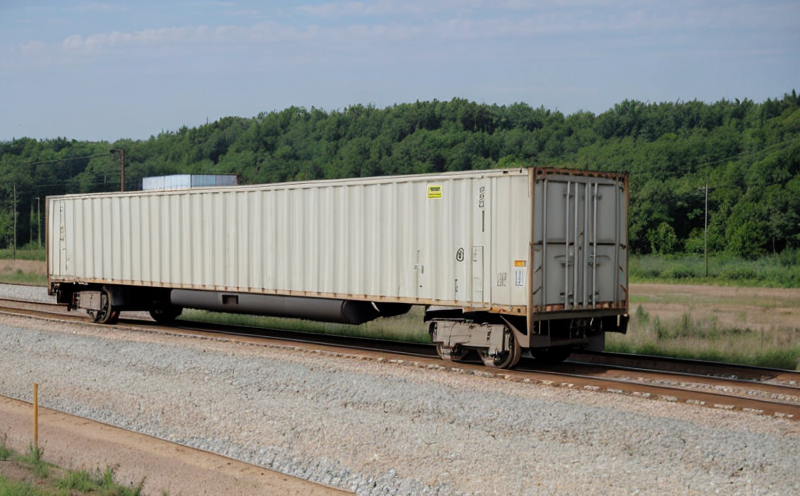UIC 571-4 Crash Energy Absorption Testing for Freight Wagons
The UIC 571-4 crash energy absorption test is a critical procedure designed to assess the ability of freight wagons to absorb and dissipate kinetic energy during collisions, ensuring safe and reliable operation in railway systems. This test is essential for meeting international safety standards set forth by the UIC (International Union of Railways). The test involves simulating a collision scenario where a freight wagon impacts another stationary object at controlled speeds, measuring how much energy the wagon can absorb before structural failure occurs.
The primary objective is to ensure that freight wagons comply with stringent safety requirements outlined in UIC standards. Compliance with these guidelines not only enhances passenger and cargo safety but also contributes significantly to the overall reliability of railway operations. By accurately measuring energy absorption, this test helps identify potential weaknesses in wagon design that could lead to catastrophic failures during accidents.
For freight wagons subjected to UIC 571-4 crash testing, the process typically begins with thorough preparation of the specimen (wagon). This includes ensuring all components are aligned correctly and securely fastened. The wagon is then placed on a specially designed test track where it will be impacted by another object traveling at predetermined velocities. These speeds vary depending upon the type of cargo being transported and environmental factors such as weather conditions.
The instrumentation used during this testing procedure includes high-resolution cameras, force sensors embedded within the impact zone, accelerometers to measure acceleration levels throughout the collision event, and strain gauges placed strategically across key structural points of the wagon. Data collected from these instruments provides detailed insights into how energy is distributed and absorbed by various parts of the vehicle.
Once testing has been completed, a comprehensive report detailing all measurements and observations must be produced. This document serves multiple purposes including serving as evidence for regulatory compliance, informing design improvements based on identified vulnerabilities, and providing valuable information to stakeholders involved in procurement decisions regarding new or refurbished wagons.
The importance of UIC 571-4 testing cannot be overstated; it plays a pivotal role in safeguarding lives and property by reducing the risk associated with rail accidents. Compliance ensures that freight wagons meet rigorous safety standards, thereby contributing to safer transportation practices across international borders.
International Acceptance and Recognition
The UIC 571-4 crash energy absorption test enjoys widespread acceptance among various countries worldwide, particularly those that adhere to European Union regulations. Countries like Germany, France, Spain, and the United Kingdom have adopted this standard as part of their national railway safety frameworks. Its recognition extends beyond Europe; it is also widely accepted in North America under similar safety protocols.
Compliance with UIC 571-4 testing ensures that freight wagons meet not only European Union requirements but also aligns them with international standards such as ISO and ASTM, further enhancing their marketability. Many global manufacturers of railway equipment choose to undergo this rigorous testing process because it demonstrates commitment to quality control and safety assurance.
For companies engaged in international business operations, achieving compliance with UIC 571-4 can open doors to lucrative contracts from governments and private enterprises alike. It also fosters trust among customers who prioritize product reliability and safety above all else. By adhering strictly to these stringent tests, businesses not only enhance their reputation but also ensure they remain competitive in an increasingly globalized market.
Competitive Advantage and Market Impact
Compliance with the UIC 571-4 crash energy absorption test provides numerous benefits for companies operating within the railway industry. Firstly, it enhances product reliability by identifying potential weaknesses early in development stages through rigorous testing procedures. Secondly, achieving compliance opens up opportunities for exports to regions where this standard is mandatory or highly desirable.
Moreover, compliance with UIC 571-4 can serve as a differentiating factor when competing against other suppliers. Potential buyers often view adherence to such stringent safety standards positively, viewing it as an indicator of high-quality manufacturing practices and commitment to customer satisfaction. This perception can translate into increased sales volumes and stronger brand loyalty.
In addition to these tangible advantages, there are intangible benefits associated with UIC 571-4 compliance. For instance, participating in rigorous testing processes fosters innovation within organizations by encouraging continuous improvement efforts aimed at enhancing performance metrics beyond mere regulatory requirements. Such initiatives contribute positively towards establishing a culture of excellence that resonates well both internally and externally.
Use Cases and Application Examples
| Use Case/Application Example | Description |
|---|---|
| Railway Accident Prevention | The UIC 571-4 test simulates real-world collision scenarios, providing crucial data on how different types of freight wagons respond under various conditions. This information helps railway operators implement effective accident prevention strategies. |
| Design Optimization | Detailed reports generated from the tests allow manufacturers to optimize designs for better energy absorption capabilities. This leads to more efficient and safer vehicles, enhancing overall performance. |
| Regulatory Compliance | Achieving UIC 571-4 compliance ensures that products meet all necessary safety requirements, enabling companies to operate legally across multiple jurisdictions without needing additional certifications. |
| Innovation and Research | The process encourages ongoing research into innovative materials and technologies capable of improving energy absorption properties. This drives industry advancement while maintaining high standards of safety. |
| Supplier Evaluation | Railway operators frequently evaluate potential suppliers based on their ability to meet stringent testing criteria like UIC 571-4. Successful completion of these tests enhances a supplier's reputation and increases chances of winning contracts. |
| Educational Purposes | The results from the test serve as valuable educational tools for training purposes, helping new engineers understand complex concepts related to structural integrity and crashworthiness in railway vehicles. |
These use cases highlight just some of the ways UIC 571-4 crash energy absorption testing benefits various stakeholders involved in the rail industry. From improving product quality to fostering innovation, this testing method plays a vital role in ensuring safe and efficient railway operations worldwide.





